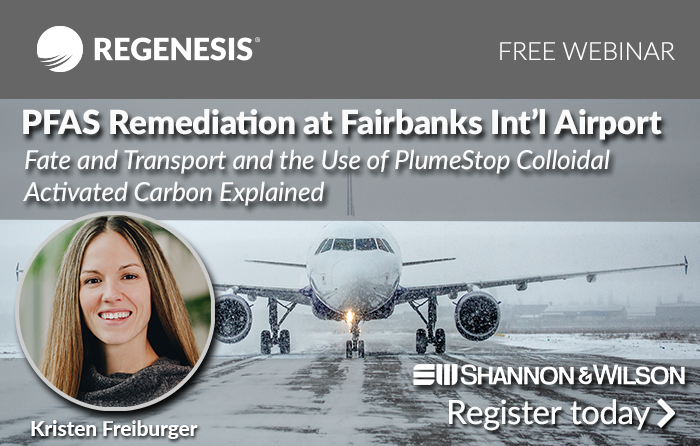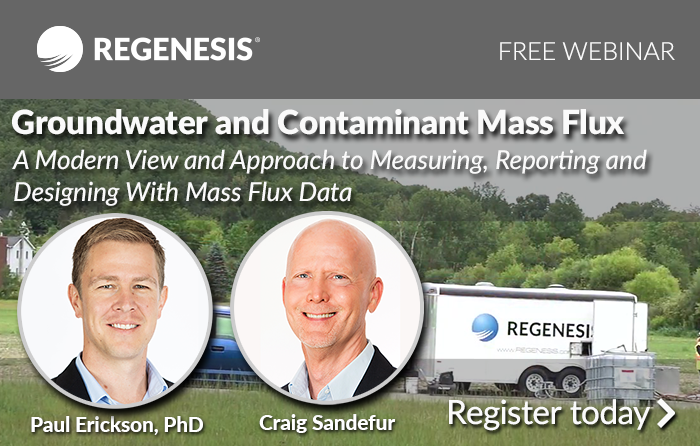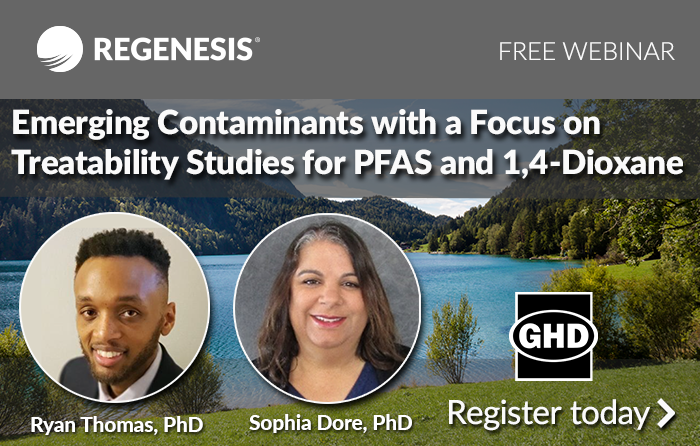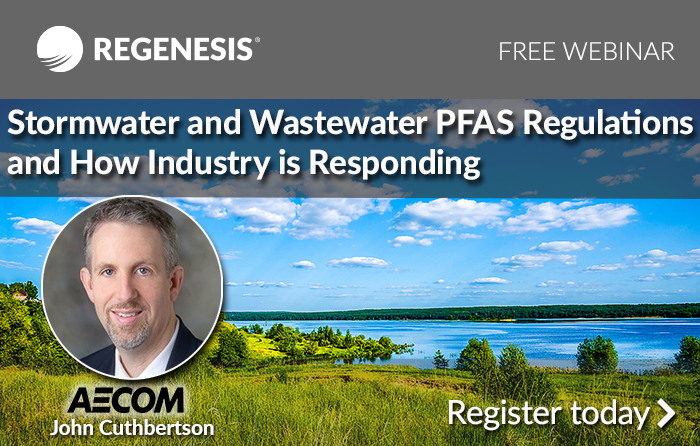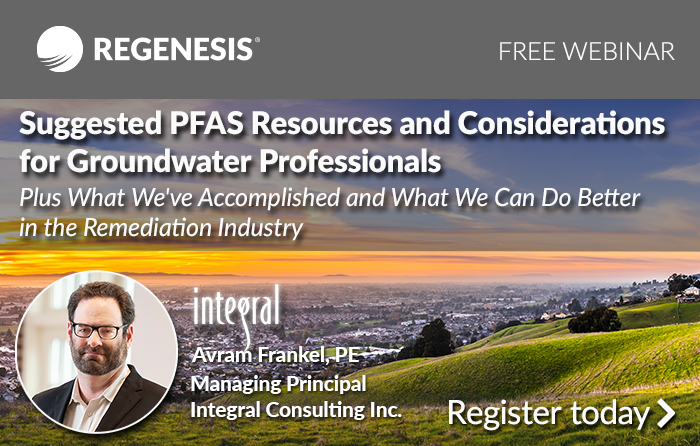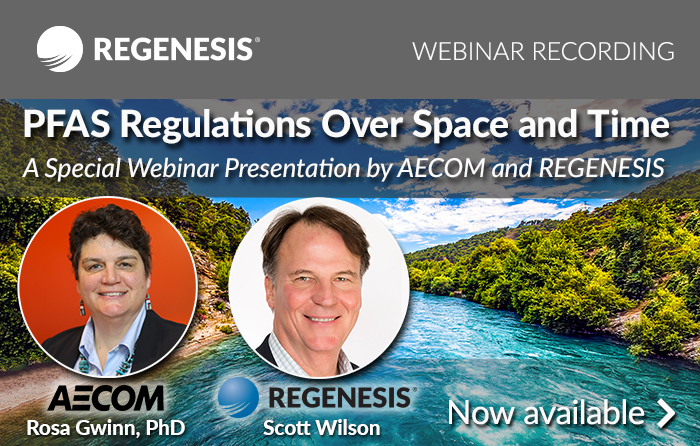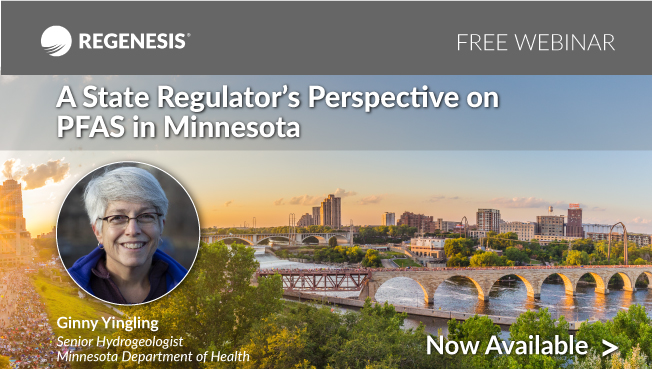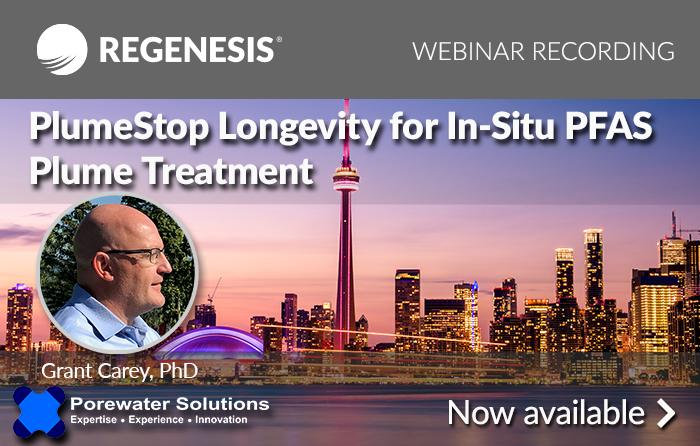PFAS Remediation at Fairbanks International Airport: Fate and Transport of PFAS and the Use of Colloidal Activated Carbon
In this webinar we were pleased to have as a special guest speaker Kristen Freiburger, Associate at Shannon & Wilson. Her presentation discussed PFAS remediation at Fairbanks International Airport, including a discussion of fate and transport of PFAS and the use of PlumeStop colloidal activated carbon.
Highlights of this free webinar:
-
- The presumed source of PFAS in groundwater in many Alaskan communities is the use of AFFF by airport rescue and firefighting at Part 139 Airports operated by Alaska DOT&PF
- Fate and transport of PFAS as it relates to projects at Gustavus and Fairbanks Airports
- Use of PlumeStop to address PFAS contamination at the Fairbanks International Airport
PFAS are highly soluble in water and have a very strong carbon-fluorine backbone making them resistant to traditional remediation technologies and natural attenuation. PFAS that enter groundwater are known to be persistent and travel long distances. Fate and transport of PFAS in groundwater depends on the environment which they were released and the physical properties of the PFAS being examined (e.g., carbon chain lengths, linear/branched isomers, functional groups, and degree of fluorination). The presumed source of PFAS in groundwater in many Alaskan communities is the use of AFFF by airport rescue and firefighting at Part 139 Airports operated by Alaska DOT&PF. When AFFF releases occur in areas served by private or public drinking water wells, the well water is susceptible to contamination. Kristen Freiburger will discuss the fate and transport of PFAS as it relates to her PFAS work of the Gustavus and Fairbanks Airports including the use of PlumeStop at the Fairbanks International Airport. This discussion will focus on the challenges of understanding fate and transport of PFAS.
Recording now available
Groundwater and Contaminant Mass Flux: A Modern View and Approach to Measuring, Reporting and Designing With Mass Flux Data
In this webinar we were pleased to have a special presentation from Paul Erickson, PhD, Director of Research & Development at REGENESIS, and Craig Sandefur, Vice President of Remedial Applications Development at REGENESIS. Their presentation discussed groundwater and contaminant mass flux and a modern approach to measuring, reporting and designing with mass flux data.
This free webinar will:
-
- Flux Tracer™ a flux measurement tool developed by REGENESIS that is easier to deploy and retrieve than alternative methods of collecting groundwater and contaminant mass flux data
- Why the data collected by direct mass flux measurements is far superior to traditional means of estimation (groundwater extraction or slug tests)
- Examples of REGENESIS Flux Tracer reports and discuss how mass flux data and are integrated into our treatment design process
Permeable Reactive Barriers are standard approach for the remediation of large elongate plumes however, PRB’s are particularly sensitive to mass flux. This makes technologies that can directly measure mass flux very valuable. Historically Remediation Practitioners have relied on Water Resource methods (GW Extraction Tests and/or Slug Tests) to measure design critical PRB aquifer characteristics. Unfortunately, these measurement methods generally provide results in terms of aquifer bulk averages and do identify or measure those contaminant mass flux zones that control contaminant migration. Results of Mass Flux provide a direct measurement and quantification of contaminant concentration measure in milligrams per liter passing through the surface area of an imaginary plane of compliance measured in meters2 for a set period of time measured in days. These three variables are exactly what is necessary to design an effective and successful PRB.
REGENESIS has developed a flux measurement tool that has a better form factor (Flux Tracer). This device has significant improvements in the areas of ease of use and reductions in time for field installation and retrieval. This Webinar will discuss the above topics as well as provide examples of REGENESIS Flux Tracer Reports and a brief discussion of the Data (Interpretation/Observations). In addition how REGENESIS designers use Flux Tracer and other mass flux data as direct PRB design inputs.
Recording now available
Emerging Contaminants with a Focus on Treatability Studies for PFAS and 1,4-Dioxane
In this webinar we were pleased to have as special guests speaker Ryan Thomas, PhD, Associate and Emerging Contaminants Practice Leader and Sophia Dore, PhD, Associate and Director of the Innovative Technology Group at GHD. Their presentation discussed emerging contaminants with a focus on treatability studies for PFAS and 1,4-Dioxane.
This free webinar will:
-
- Provide a general overview of emerging contaminants
- Identify the regulations in the various states
- Overview available analytical methods and treatment technologies
- Offer proactive considerations related to addressing PFAS and 1,4-Dioxane concerns
- Provide an overview of the application of laboratory studies to study treatment of PFAS and 1,4-Dioxane
- Provide case studies where treatability studies were used to understand and model treatment of PFAS and 1,4-Dioxane
Emerging Contaminants consist of synthetic or naturally occurring chemicals or microorganisms that are not routinely monitored in the environment but have the potential to impact sensitive receptors such as drinking water sources and other water sources and potentially cause negative human health and/or ecological effects. These contaminants are increasingly being detected in water, soil, landfill leachate, and other media. As a result of emerging contaminants being detected in the environment, evaluations to determine the need for regulation are routinely performed that may impact many water and environmental professionals. Of the numerous potential emerging contaminants, per- and polyfluoroalkyl substances (PFAS) and 1,4-dioxane are consistently being evaluated for stringent regulation at the Federal and State levels.Treatability studies model processes occurring in the environment or in treatment plants at a small scale. They are particularly well suited to emerging contaminants because procedures and doses for treatment are not well established and the ability to test multiple doses/retention times or other treatment parameters within a short period of time to determine the optimum treatment is an advantage.
Webinar recording now available
Identifying PFAS as a CERCLA Hazardous Substance: Are You Ready for This?
In this webinar we were pleased to have a special presentation from Ned Witte, Attorney at Godfrey & Kahn, S.C. Ned’s presentation discussed collateral consequences of identifying PFAS as a CERCLA hazardous substance.
This free webinar will discuss the following collateral consequences of identifying PFAS as a CERCLA hazardous substance:
- U.S.EPA CERCLA administrative order and cost recovery authority
- Private party cost recovery and contribution actions
- Impacts on CERCLA five-year reviews and closed sites
- CERCLA defenses and exemptions, including the innocent landowner defense and bona fide prospective purchaser eligibility
- Interface with state PFAS regulations
- Applicable or Relevant and Appropriate Requirements (ARARs)
- Environmental due diligence and the evolution of the ASTM standard to address PFAS and emerging contaminants
- Impacts on transactions and Brownfields
On July 13, 2021, the United States House of Representatives approved the PFAS Action Act, which currently sits before the United States Senate for further action and possible approval. If enacted, the PFAS Action Act would require the United States Environmental Protection Agency to designate two PFAS, known as PFOA and PFOS, as Comprehensive Environmental Response Compensation and Liability Act “hazardous substances” within one year and to make a similar determination on other PFAS substances within five years. Some observers believe that if Congress doesn’t pass PFAS legislation, U.S.EPA may act on its own. Such a CERCLA hazardous substance identification sounds intuitively appropriate, but what are the practical effects? Join Ned Witte, an experienced PFAS lawyer and lecturer, as he discusses collateral consequences of identifying PFAS as a CERCLA hazardous substance.
View webinar recording
Stormwater and Wastewater PFAS Regulations and How Industry is Responding
In this webinar we were pleased to have as a special guest speaker John Cuthbertson, Associate Vice President and North America Industrial PFAS Lead at AECOM. Mr. Cuthbertson’s presentation looked at stormwater and wastewater PFAS regulations and how industry is responding. He was joined by Scott Wilson, President & CEO at REGENESIS, who shared the latest developments about colloidal activated carbon’s use in the remediation industry as a low-cost method of eliminating PFAS risk.
Highlights of this webinar:
- Several states have taken different and unique approaches to regulate and identify PFAS sources to stormwater and wastewater
- Facilities are being required to address PFAS discharges in stormwater and wastewater rapidly
- Several case studies will provide insight for how facilities are responding to these regulatory drivers
- An update on the use of PlumeStop to eliminate risk on PFAS sites globally
Sign up today
Suggested PFAS Resources and Considerations for Groundwater Professionals – Plus What We’ve Accomplished and What We Can Do Better in the Remediation Industry
In this webinar we were pleased to have a special presentation by Avram Frankel, P.E., Managing Principal at Integral Consulting Inc.. His presentation discussed PFAS resources and considerations for groundwater professionals, plus what we’ve accomplished and what we can do better in the remediation industry. He was joined by Ryan Moore, PFAS Program Manager at REGENESIS, who discussed in situ treatment of PFAS using colloidal activated carbon to eliminate PFAS risk at a low cost.
Highlights of this webinar:
- The evolution of remediation hydraulics, direct push technologies, next generation in situ reagents, and integrated site remediation and drinking water treatment strategies.
- Key market forces that continue to shape our industry such as insurance, government funding and litigation.
- What has been achieved in the remediation industry, what could be done better, and how we will meet new challenges.
- An update on the use of PlumeStop to eliminate risk on PFAS sites globally.
This webinar will expand on these topics, touch on some broader environment, social and governance topics, and highlight some important considerations in the assessment and mitigation of emerging contaminants such as per-and polyfluoroalkyl substances, a topic Mr. Frankel explored in recent article published in the journal Groundwater (https://doi.org/10.1111/gwat.13101).
Recording Now Available
PFAS Regulations Over Space and Time
In this webinar we were pleased to have as a special guest speaker Rosa Gwinn, PhD PG, Global PFAS Technical Lead at AECOM. Dr. Gwinn’s presentation looked at where PFAS regulations started and where they may be headed globally, including the United States. She was joined by Scott Wilson, President & CEO at REGENESIS, who shared the latest developments about colloidal activated carbon’s use in the remediation industry as a low-cost method of eliminating PFAS risk.
Highlights of this free webinar:
- Where PFAS regulations started and where they may be headed globally, including the United States
- A brief explanation of how public health concerns about PFAS created the pressure to drive regulatory actions that differed country-by-country and state-by-state
- How public health interest and research funding are rapidly changing the scientific understanding of the behavior, toxicity, and fate of individual PFAS in the environment
- Predicting the future of regulations based on what has happened in different jurisdictions
- An update on the use of PlumeStop to eliminate risk on PFAS sites globally
Recording now available
A State Regulator’s Perspective on PFAS in Minnesota
In this webinar we were pleased to have as a special guest speaker Ginny Yingling, Senior Hydrogeologist at Minnesota Department of Health. Her presentation shared a state regulator’s perspective on PFAS in Minnesota. She was joined by Scott Wilson, President & CEO at REGENESIS, who discussed the extent to which colloidal activated carbon has been accepted by the remediation industry as a low-cost method of eliminating PFAS risk.
Highlights of this free webinar:
- Updates on the investigation of several legacy PFAS waste disposal sites that impacted the drinking water of over 140,000 residents in 18 suburban communities east of St. Paul and contaminated the groundwater in an area of over 150 square miles
- The important role that surface water transport of PFAS has played at two sites in Minnesota
- Actions the state is taking to address the situation in the wake of the 3M settlement
- How Minnesota is looking forward to addressing PFAS statewide
View this free webinar
PlumeStop® Longevity for In-Situ PFAS Plume Treatment
In this webinar we were pleased to have as a special guest speaker Grant Carey, Ph.D., President of Porewater Solutions. His presentation discussed PlumeStop longevity for in-situ PFAS plume treatment. He was joined by Ryan Moore, PFAS Program Manager at REGENESIS, who discussed in-situ treatment of PFAS using colloidal activated carbon to eliminate PFAS risk at a low cost.
Highlights of this free webinar:
- Modeling the performance results of PFAS-impacted groundwater sites treated with colloidal activated carbon, including model runs to evaluate longevity sensitivity at AFFF sites
- How some of the design parameters may be engineered to improve longevity
- Several new research projects with the University of Waterloo, University of Toronto, and Carleton University to update the ISR-MT3DMS model functionality to improve our ability to model PlumeStop longevity for PFAS
View this free webinar
Six Pilot-Scale Studies Evaluating the In-Situ Treatment of PFAS in Groundwater
Highlights of this free webinar:
- The results from the adsorption-based permeable reactive zones (PRZ) indicated that attenuation of the PFAS was occurring.
- Colloidal activated carbon (CAC)-based PRZ showed the best performance with all the PFAS analyzed being removed to below their respective detection limits (10 ng/L).
- The powdered activated carbon (PAC)-based PRZ showed variable treatment.
- The biochar and ion exchange resins (IER) PRZs initially attenuated the PFAS but then had breakthrough of the C4 PFAS compounds prior to the 6-month post-injection sampling event, with the remainder of the PFAS compounds breaking through prior to the 9-month post injection sampling event.
In this webinar we were pleased to have as a special guest speaker Rick McGregor, President of InSitu Remediation Services Ltd. His presentation discussed six pilot-scale studies evaluating the in-situ treatment of PFAS in groundwater. PFAS are an emerging suite of compounds that have gathered wide-spread attention but have few remedial options. Research and limited field studies suggest that some reagents have promise for the removal of PFAS from groundwater. Six reagents were chosen for pilot testing including hydrogen peroxide, unactivated sodium persulfate, CAC, PAC, biochar and IER to determine if the reagents could be effective at reducing/removing the PFAS. Various PFAS were detected within the pre-treatment groundwater including PFDS, PFBA, PFPeA, PFHxA, PFHpA, PFOA, PFOS and PFNA with concentrations ranging up to 18,000 ng/L for PFPeA. Six pilot-scale permeable reactive zones (PRZs) were created in a shallow, unconfined aquifer situated in a slightly saline, sulfate-iron reducing environment. The groundwater was also impacted with gasoline-range petroleum hydrocarbons along with various additives including MTBE and TBA.

 Americas
Americas Europe
Europe Français
Français Deutsch
Deutsch Italiano
Italiano Español
Español